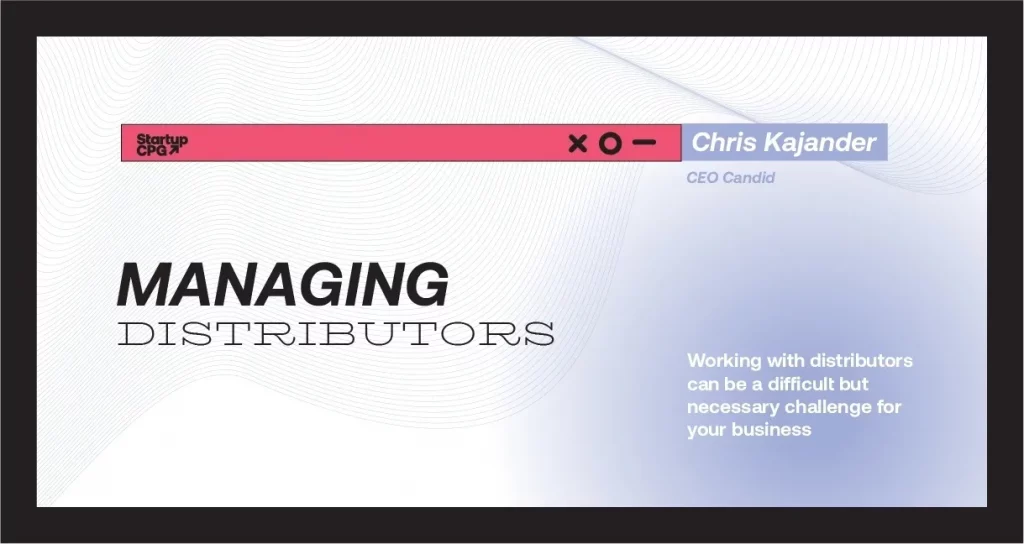Managing
Distributors
Chris Kajander has been working in CPG for nearly a decade. He is the co-founder and CEO of Candid and a founding member of Broadleaf Digital . He is passionate about sustainable sourcing, sustainable packaging, and food justice.
Working with a distributor can be confusing and sometimes frustrating. But good distribution can lead to new doors, new consumers, and increased revenue. I’m not sure that there’s necessarily a “key” to working with distributors, but knowing a few of the “watch-outs” and building good relationships with distributor reps and category managers can lead to fruitful business. Check out Rodeo CPG’s article on promotional planning here. I’ll use that article as a reference point, expand on a few areas and talk through some common pitfalls and how to avoid them.
Broadline Distribution
If you have ambitions of working with Whole Foods and other big natural retailers, you’ll likely need to work with UNFI and KeHE. If you’re a newer brand you may want to start through UNFI’s UpNext program and/or KeHE’s New@KeHe program. These programs are designed to ease brands into the system and give you a chance to succeed and learn at a regional level.
Broadline Risks – Beware Bridge Buying
Working with distributors can create lumpy sales patterns (high one month, low the next). You have great March for sales when you’re offering a promotional discount, but then don’t get a reorder until June. Some sales lumpiness is unavoidable, but this is a common result of how promotional planning can be both a blessing or a curse depending on how the promotion is executed. Bridge buying, which is when a distributor uses one of your promotional periods to over-buy your products at a discount, is one of the potential risks of OIs (OI = Off-Invoice: When a discount is deducted straight from a brand’s invoice from a distributor). There are a few things you can do to mitigate this risk:
- A high off-invoice discount (usually over 15%) can trigger a bridge buy. Keep your OIs between 10-15%.
- Stack your promotional planning and leverage it with distributors and retailers so that when you’re on discount, that discount really moves the sales needle. What does that look like? Say you’re offering a 15% OI to the distributor, they will (hopefully) pass some of that discount down to retailers to buy your product. However, a 15% discount may not be enough for the retailers to pass on a deal to their customers. So, while you’ve incentivized the distributor and retailer to buy your product, there isn’t anything in place for the end consumer. So, you might line up an MCB (MCB = Manufacturer Charge Back: When a retailer buys a product, at a discount, from a distributor and the distributor deducts the amount from a brand’s invoice. Distributors usually charge a fee/upcharge for this) or a scan-back to move the needle with both retailers and consumers. And if you’re lining up an MCB with retailers to coincide with your OI, try to leverage that big promotional push to get a secondary or tertiary display in store, promotional signage, or being moved to a better (more visible) spot on shelf. The point of a promotion is movement at every level: the distributor buys more product, retailers buy more product or try your product for the first time, and consumers take a chance on your item because you’ve lined up a great deal. It takes a coordinated effort to pass a discount down through the food chain. The key is to communicate with all your partners and make sure it’s executed properly at each point, from retail buyers knowing the deal is coming, to having proper signage on shelf letting customers know your product is on sale. That will hopefully prevent distributors and (sometimes) retailers from having a surplus of product that takes a while to sell through, leaving you without new POs for many moons.
- With many distributors you can push back and revise POs if you’re concerned with the amount they’re ordering. This can a way to avoid bridge buys.
Chargebacks
Chargebacks can be a nightmare for brands if not properly negotiated and managed.
- You may be “encouraged” to offer up free-fills to open up accounts. If you can, avoid freefills. Unfortunately, they’re not always avoidable, especially if a larger chain demands them. Just be aware that you will be charged back the “listing price” to retailers for your product, not your wholesale price to distributors. So know your list price and don’t authorize blanket freefills.
- More established brands will have people on salary that spend all of their time combing through chargebacks and disputing them. Let that sink in.
A Quick Tip to Consider
Velocity will be measured at the store level by units sold, but distributors (and retailers) will often measure success by cases sold. So if your master case has twelve retail case packs in it and your retail case packs each have 24 units, then it may take a longer time to get a reorder than if each master case had two retail cases and each retail case had twelve units. So if possible, it’s better to have a smaller master-case pack size and/or retail case pack size. It helps with both velocity and perceived velocity.
DSD (DSD: Direct Store Delivered) Distribution
DSDs are local or regional distributors that service smaller accounts and sometimes larger chains as well. There is a lot of variance in DSDs, who they service, how they work, and what kind of margins they take. It’s been my experience that managing through the distribution reps and offering good incentives (usually a SPIFF, SPIFF = Sales Program Incentive Funds) can help move product. DSD reps often have 100+ brands they’re working with, so you’ll need to communicate effectively and make it worth their while to sell you in and keep the reorders coming.
DSD Contracts
Pay attention to what you sign. A lot of times a DSD will try to lock in the exclusive rights to distribute your brand and charge you a large fee to break that contract. So it’s important to make sure they’re the right fit and if you have other distribution already in place, carve that out and make sure they can’t claim it (unless you want to hand that business over).
Hope this article is helpful to anyone looking to expand their distribution footprint!






All Comments